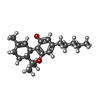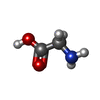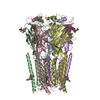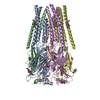+Search query
-Structure paper
| Title | Structural basis for cannabinoid-induced potentiation of alpha1-glycine receptors in lipid nanodiscs. |
|---|---|
| Journal, issue, pages | Nat Commun, Vol. 13, Issue 1, Page 4862, Year 2022 |
| Publish date | Aug 18, 2022 |
 Authors Authors | Arvind Kumar / Kayla Kindig / Shanlin Rao / Afroditi-Maria Zaki / Sandip Basak / Mark S P Sansom / Philip C Biggin / Sudha Chakrapani /   |
| PubMed Abstract | Nociception and motor coordination are critically governed by glycine receptor (GlyR) function at inhibitory synapses. Consequentially, GlyRs are attractive targets in the management of chronic pain ...Nociception and motor coordination are critically governed by glycine receptor (GlyR) function at inhibitory synapses. Consequentially, GlyRs are attractive targets in the management of chronic pain and in the treatment of several neurological disorders. High-resolution mechanistic details of GlyR function and its modulation are just emerging. While it has been known that cannabinoids such as Δ-tetrahydrocannabinol (THC), the principal psychoactive constituent in marijuana, potentiate GlyR in the therapeutically relevant concentration range, the molecular mechanism underlying this effect is still not understood. Here, we present Cryo-EM structures of full-length GlyR reconstituted into lipid nanodisc in complex with THC under varying concentrations of glycine. The GlyR-THC complexes are captured in multiple conformational states that reveal the basis for THC-mediated potentiation, manifested as different extents of opening at the level of the channel pore. Taken together, these structural findings, combined with molecular dynamics simulations and functional analysis, provide insights into the potential THC binding site and the allosteric coupling to the channel pore. |
 External links External links |  Nat Commun / Nat Commun /  PubMed:35982060 / PubMed:35982060 /  PubMed Central PubMed Central |
| Methods | EM (single particle) |
| Resolution | 2.61 - 3.61 Å |
| Structure data | EMDB-23700, PDB-7m6m: EMDB-23701, PDB-7m6n: EMDB-23702, PDB-7m6o: EMDB-23703, PDB-7m6p: EMDB-23704, PDB-7m6q: EMDB-23705, PDB-7m6r: EMDB-23706, PDB-7m6s: |
| Chemicals |  ChemComp-TCI:  ChemComp-GLY:  ChemComp-NAG: |
| Source |
|
 Keywords Keywords | MEMBRANE PROTEIN / Ions Ligands Receptors / Glycine receptor Recombinant Proteins |
 Movie
Movie Controller
Controller Structure viewers
Structure viewers About Yorodumi Papers
About Yorodumi Papers


















